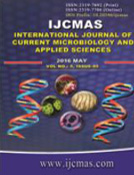


 National Academy of Agricultural Sciences (NAAS)
National Academy of Agricultural Sciences (NAAS)

|
PRINT ISSN : 2319-7692
Online ISSN : 2319-7706 Issues : 12 per year Publisher : Excellent Publishers Email : editorijcmas@gmail.com / submit@ijcmas.com Editor-in-chief: Dr.M.Prakash Index Copernicus ICV 2018: 95.39 NAAS RATING 2020: 5.38 |
Palaeopalynological study was conducted in relation to reconstruct the palaeovegetation and palaeo climatic condition of our college area. For this purpose samples were collected from Lady Brabourne College premises, Park Circus [central-east zone of Kolkata] area. Our present study reveals the deposition age nearly from 7000-2000 yrs BP, confirming the Late-Quaternary age of the samples. At lower layer (40 ft), sample reveals vegetation as open grassland type. Presence of grass pollen, fern spores along with Heritiera and palms in little amount were recorded. Occurrence of Typha pollen indicates marshy habitat. Middle layer (33-27 ft) unfolds a mixed forest type including Heritiera, Suaeda, and grass pollen indicating the transition from saline to fresh water environment. At upper layer (23-19 ft), Heritiera was uniformly present along with fern spores, Suaeda, grass pollen etc. So the present study unfolds that mangrove vegetation was dominated in this region during Late-quaternary period. Occurrence of grass pollen throughout the strata indicates the prevalence of equable temperature and also human interference in the investigated area. Presence of various types of fungal spores throughout the strata indicates that the climatic condition was tropical with high humidity. Deposition of peat layers indicates strong and extensive river discharges which coincides with the intensification of monsoonal rainfall at summer. Environment was mixed type with brackish & fresh water because floral vegetation was regular inundated with sea water. Due to salinity in water source, water supply of plants was mostly from soil moisture. So, it is assumed that, before 2000 yrs Kolkata was a part of Sunderbans.
 |
 |
 |
 |
 |